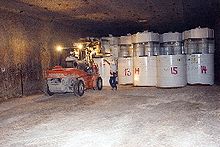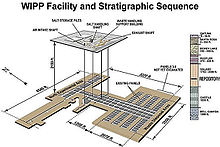Waste Isolation Pilot Plant
- Waste Isolation Pilot Plant
-

Einlagerung von radioaktiven Abfällen in die WIPP
Die Waste Isolation Pilot Plant (WIPP) ist ein Endlager für radioaktive Abfälle, das in einer Salzformation in der Nähe von Carlsbad im US-amerikanischen Bundesstaat New Mexico errichtet wurde. Die Anlage dient der Entsorgung von Abfällen mit hohem Gehalt an Alphastrahlern (sogenannte "Transuranabfälle").
Seit 1955 wurden in den USA Salzformationen für die Einlagerung radioaktiver Abfälle in Betracht gezogen. Mit dem Bau der WIPP wurde 1980 begonnen. Im März 1999 wurde die Anlage mit der ersten Anlieferung von radioaktiven Abfällen des Los Alamos National Laboratorys in Betrieb genommen. Seitdem werden dort in rund 650 m Tiefe die Transuranabfälle aus neun mit militärischen Aufgaben befassten US-Anlagen (Rocky Flats, Los Alamos National Laboratory, Idaho National Laboratory, Hanford Site u. a.) eingelagert. Der Einlagerungsbereich besteht aus acht Feldern (Panels) mit jeweils sieben Streckenkammern (Rooms). Die Einlagerungskapazität beträgt rund 180.000 m³.
WIPP ist weltweit das erste in Betrieb genommene Endlager auch für hochradioaktive Abfälle, die in diesem Fall aus der Atomwaffen-Produktion stammen. Es befindet sich in einem sehr dünn besiedelten Gebiet, die Standort-Provinz Eddy County hat eine Bevölkerungsdichte von 5 Personen pro Quadratkilometer.[1]
Literatur
Einzelnachweise
- ↑ National Geographic (D), Juli 2002
Weblink
32.371722222222-103.79354166667
Wikimedia Foundation.
Schlagen Sie auch in anderen Wörterbüchern nach:
Waste Isolation Pilot Plant — The Waste Isolation Pilot Plant, or WIPP, is the world s second underground repository (after closure of the Germany s Asse Salt Mine in 1977) licensed to safely and permanently dispose of transuranic radioactive waste that is left from the… … Wikipedia
Waste Isolation Pilot Plant — Installations de surface du WIPP en 2004. Le Waste Isolation Pilot Plant (WIPP) est un centre de stockage de déchets radioactifs militaires et issus de la recherche installé dans la commune de Carlsbad dans le sud est du Nouveau Mexique. Il est… … Wikipédia en Français
Stored Waste Examination Pilot Plant — The Stored Waste Examination Pilot Plant (SWEPP) is a facility at the Idaho National Laboratory for nondestructively examining containers of radioactive waste to determine if they meet criteria to be stored at the Waste Isolation Pilot Plant.… … Wikipedia
Radioactive waste — 2007 ISO radioactivity danger logo, designed in part for long term radioactive waste depositories which might survive into a far future time in which all knowledge of the meaning of present common radiation danger symbols and signs has been lost… … Wikipedia
Transuranic waste — is defined as: Waste containing more than 100 nanocuries of alpha emitting transuranic isotopes per gram of waste with half lives greater than 20 years, except for high level radioactive waste...All TRU elements are heavier than uranium, have… … Wikipedia
Yucca Mountain nuclear waste repository — Yucca Mountain The proposed design … Wikipedia
Rocky Flats Plant — The Rocky Flats Plant was a United States nuclear weapons production facility near Denver, Colorado that operated from 1952 to 1992. It was under the control of the United States Atomic Energy Commission (AEC) until 1977, when it was replaced by… … Wikipedia
List of waste management acronyms — The following article contains a list of acronyms used in the waste management industry. [ [http://www.ciwm.co.uk/mediastore/FILES/11384.doc Waste management jargonyms] CIWM website, Accessed 9/11/06] [ [http://www.environment… … Wikipedia
Low level waste — (LLW) is a term used to describe nuclear waste that does not fit into the categorical definitions for high level waste (HLW), spent nuclear fuel (SNF), transuranic waste (TRU), or certain byproduct materials known as 11e(2) wastes, such as… … Wikipedia
List of nuclear waste treatment technologies — The following list shows different methods of treating and disposing of nuclear waste:*Deep geological repository *Dry cask storage *Ducrete *Ocean floor disposal *Saltcrete *Spent fuel pool *Spent nuclear fuel shipping cask *Synroc *Waste… … Wikipedia
 Commons: Waste Isolation Pilot Plant – Sammlung von Bildern, Videos und Audiodateien32.371722222222-103.79354166667Koordinaten: 32° 22′ 18″ N, 103° 47′ 37″ WKategorien:
Commons: Waste Isolation Pilot Plant – Sammlung von Bildern, Videos und Audiodateien32.371722222222-103.79354166667Koordinaten: 32° 22′ 18″ N, 103° 47′ 37″ WKategorien:

